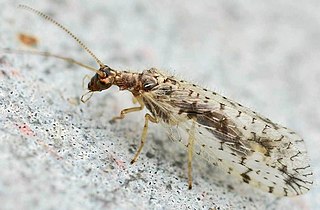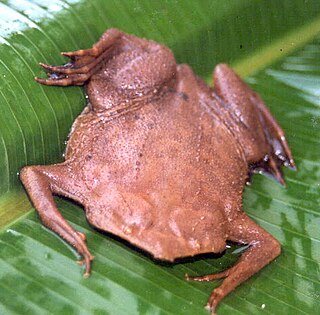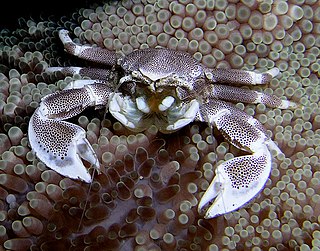
The insect order Neuroptera, or net-winged insects, includes the lacewings, mantidflies, antlions, and their relatives. The order consists of some 6,000 species. Neuroptera is grouped together with the Megaloptera and Raphidioptera (snakeflies) in the unranked taxon Neuropterida.

The family Prophalangopsidae are insects belonging to the order Orthoptera. They are the only extant members of the superfamily Hagloidea. There is only one extant genus in North America, where they are known as grigs, four genera in Asia, and many extinct genera.

Ammonitida or "True ammonites" are an order of ammonoid cephalopods that lived from the Jurassic through Paleocene time periods, commonly with intricate ammonitic sutures.

Mantispidae, commonly known as mantidflies, mantispids, mantid lacewings, mantisflies or mantis-flies, is a family of small to moderate-sized insects in the order Neuroptera. There are many genera with around 400 species worldwide, especially in the tropics and subtropics. Only five species of Mantispa occur in Europe. As their names suggest, members of the group possess raptorial forelimbs similar to those of the praying mantis, a case of convergent evolution.

Orussoidea is a superfamily of sawflies. It contains the living family Orussidae, as well as the extinct families Burmorussidae and Paroryssidae. They are the group of sawflies closest to the Apocrita, the group containing wasps, bees and ants, with both groups together forming the clade Euhymenoptera. Like most members of Apocrita, but unlike other sawflies, members of the superfamily are parasitoids.

Cicadomorpha is an infraorder of the insect order Hemiptera which contains the cicadas, leafhoppers, treehoppers, and spittlebugs. There are approximately 35,000 described species worldwide. Distributed worldwide, all members of this group are plant-feeders, and many produce either audible sounds or substrate vibrations as a form of communication. The earliest fossils of cicadomorphs first appear during the Late Permian. Notable extinct members include the "giant cicadas" belonging to Palaeontinidae.

Anaxyelidae is a family of incense cedar wood wasps in the order Hymenoptera. It contains only one living genus, Syntexis, which has only a single species, native to Western North America. Fossils of the family extend back to the Middle Jurassic, belonging to over a dozen extinct genera, with a particularly high diversity during the Early Cretaceous. Syntexis lay eggs in the sapwood of conifers, preferring recently burnt wood.

The Evanioidea are a small hymenopteran superfamily that includes three extant families, two of which are much more closely related to one another than they are to the remaining family, Evaniidae. The rich fossil record, however, helps fill in the gaps between these lineages. They all share the trait of having the metasoma attached very high above the hind coxae on the propodeum.

Hemerobiidae is a family of Neuropteran insects commonly known as brown lacewings, comprising about 500 species in 28 genera. Most are yellow to dark brown, but some species are green. They are small; most have forewings 4–10 mm long. These insects differ from the somewhat similar Chrysopidae not only by the usual coloring but also by the wing venation: hemerobiids differ from chrysopids in having numerous long veins and forked costal cross veins. Some genera are widespread, but most are restricted to a single biogeographical realm. Some species have reduced wings to the degree that they are flightless. Imagines (adults) of subfamily Drepanepteryginae mimic dead leaves. Hemerobiid larvae are usually less hairy than chrysopid larvae.

Hydrophiloidea, known as water scavenger beetles, is a superfamily of beetles. Until recently it included only a single family, the Hydrophilidae, but several of the subfamilies have been removed and raised to family rank. Hydrophiliidae remains by far the largest member of the group, with nearly 3,000 described species. The other families have no more than 400 species. The Histeroidea are closely related and sometimes considered part of a sensu lato Hydrophiloidea. The majority of the clade is aquatic, which is thought to be the ancestral ecology of the group, with some lineages like Sphaeridiinae becoming secondarily terrestrial. Modern representatives of the group first appeared during the Late Jurassic.

Ammonitina comprises a diverse suborder of ammonite cephalopods that lived during the Jurassic and Cretaceous periods of the Mesozoic Era. They are excellent index fossils, and it is often possible to link the rock layer in which they are found to specific geological time periods.

Psychopsidae is a family of winged insects of the order Neuroptera. They are commonly called silky lacewings.

Rhachiberothidae, sometimes called thorny lacewings, are a family of winged insects in the order Neuroptera. The family has only 14 extant species in four genera found in Sub-Saharan Africa, but has a diverse fossil record extending back to the Early Cretaceous in Lebanon, Eurasia and North America. Like the closely related Mantispidae members of the group possess raptorial forelegs, which probably only evolved once in the common ancestor of the groups.

Pipoidea are a clade of frogs, that contains the most recent common ancestor of living Pipidae and Rhinophrynidae as well as all its descendants. It is broadly equivalent to Xenoanura.

Perisphinctoidea, formerly Perisphinctaceae, is a superfamily of Middle Jurassic (Bajocian) to Lower Cretaceous (Barremian) ammonites, commonly with evolute shells with strong ribbing that typically divides about mid flank before crossing the venter.

Osmyloidea is a euneuropteran superfamily in the lacewing order Neuroptera sister to the superfamilies Dilaroidea, Mantispoidea, and the clade Neoneuroptera. The superfamily includes three living families and two extinct families described from the fossil record.

The Galatheoidea are a superfamily of decapod crustaceans comprising the porcelain crabs and some squat lobsters. Squat lobsters within the three families of the superfamily Chirostyloidea are not closely related to the squat lobsters within the Galatheoidea. The fossil record of the superfamily extends back to the Middle Jurassic genus Palaeomunidopsis.

Artematopodidae is a family of soft-bodied plant beetles in the superfamily Elateroidea. They are mostly found in understory forest foliage. The life history of the group is obscure, larvae of the genera Eurypogon and Macropogon likely feed on moss, while the larvae of Artematopus have been fed insect remains. The oldest fossils of the family date to the Middle Jurassic.

Heloridae is a family of parasitic wasps in the superfamily Proctotrupoidea, known primarily from fossils, and only one extant genus, Helorus, with 12 species found worldwide. Members of Helorus are parasitic on green lacewings.

Dipteromantispidae is an extinct family of neuropterans known from the Cretaceous period. Unlike other neuropterans, the family possesses only a single set of fully developed forewings, with the hindwings reduced to haltere-like structures. They are generally small in size and possess raptorial forelegs. They are considered to belong to Mantispoidea, with an uncertain position within the clade. Some authors have suggested that they represent a subgroup of Mantispidae, and should instead be referred to as the subfamily Dipteromantispinae within that family.




















